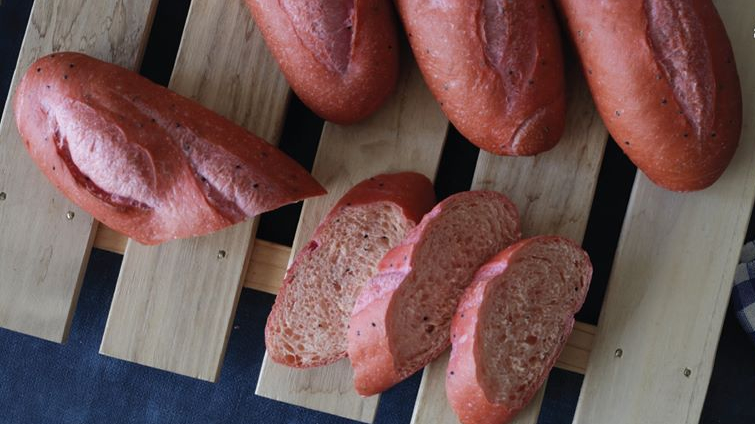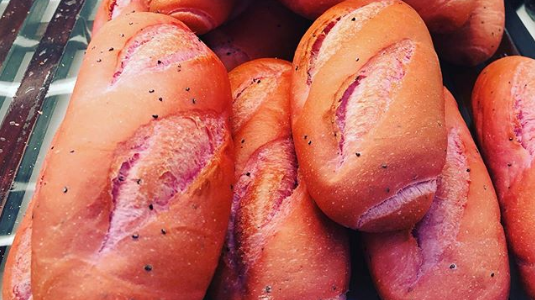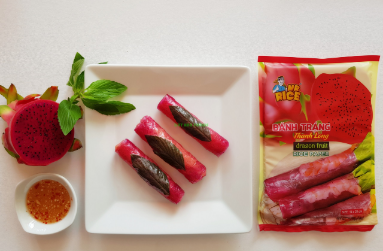
ABC Bakery in Ho Chi Minh City substituted water with dragon fruit juice to help reduce the losses of farmers hit by slumping exports to China amid the coronavirus outbreak. /ABC Bakery
ABC Bakery in Ho Chi Minh City substituted water with dragon fruit juice to help reduce the losses of farmers hit by slumping exports to China amid the coronavirus outbreak. /ABC Bakery
When life gives you lemons, make lemonade. But what if life hands you dragon fruit – and lots of it – instead? It's a question that Vietnamese businesses have been pondering for weeks now, and they seem to have found the answer.
Pink foods have taken over the Southeast Asian nation since February with baguettes, noodles and rice papers taking on a bubblegum hue as eateries infuse local favorites with dragon fruit.
The colored concoctions have been such a hit in Vietnam that KFC is rolling out this week a chicken burger with buns dyed in pink, according to Business Insider.
While millennials might be tickled pink with the new offerings, the trend reportedly serves a cause greater than racking up Instagram likes: keeping farmers afloat amid the COVID-19 outbreak.

The pulp of dragon fruit has natural pigments that impart a pink color to the bread. /Instagram
The pulp of dragon fruit has natural pigments that impart a pink color to the bread. /Instagram
The new coronavirus put a dent in Vietnam's exports to China last month as the outbreak forced authorities to temporarily close border crossings between the two countries, disrupting overland trade of fruits and vegetables.
China accounts for up to 24 percent of Vietnam's total exports of agricultural products, according to the country's Minister of Agriculture and Rural Development Nguyen Xuan Cuong.
Local farmers of the magenta-colored fruit found themselves in a pickle. Their crop is highly perishable, and China is their main buyer, snapping up 80 percent of the volume earmarked for export. With China-bound deliveries delayed and local demand unable to keep up with excess supply, prices dipped by 87.5 percent in February.
One kilogram of the red-skinned red-fleshed variety fetched as little as 21 U.S. cents on the market, down from 1.50 U.S. dollars.
Many farmers reportedly opted to leave their crops to rot in the fields to limit their losses.
In a bid to use up the unsold fruit, a bakery in Ho Chi Minh City worked out a dough recipe that swaps most of the water for the juiced pulp of red dragon fruit. The result was a loaf of bread with a pink crust dotted with specks of black seeds. Online reviews said the baguette tastes slightly sweet with a faint trace of fruitiness.
The new invention led to block-long queues amid reports people were queuing up for over an hour to get their hands on the breakout banh mi.
The bakery's initiative bore fruits. Between mid-February and early March, it went through over 30 tons of dragon fruits, according to Business Insider. The bakery even shared its recipe online so other bakeries can get in on the action and prevent produce from going to waste.

These rice paper sheets are made with dragon fruit. /Duy Anh Foods Import Export Co., Ltd
These rice paper sheets are made with dragon fruit. /Duy Anh Foods Import Export Co., Ltd
Other businesses around the country also incorporated the fruit into their products. A milling company developed pink noodles, while a manufacturer of rice-based products churned out purple rice paper and vermicelli made with watermelon.
In a sign of the trend's success, KFC is also reportedly jumping on the pink food bandwagon, debuting on March 20 a new burger featuring pink-tinted buns in selected stores for a limited time.
Since their slump, dragon fruit prices have partially rebounded as Vietnam sought new markets for its exports, and trade with China resumed in part after the two countries agreed to reopen several border checkpoints.
In late February, a train service transporting fruits from Vietnam to China also officially opened. The inaugural shipment – 156 tons of dragon fruits – traveled from the border town of Dong Dang to the city of Pingxiang in south China's Guangxi Zhuang Autonomous Region. The shipping route is expected to transport an estimated 60,000 tons of fruits a year, allowing Vietnamese farmers to reach their customers in China within days and without risking spoilage.